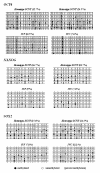Donor-host mitochondrial compatibility improves efficiency of bovine somatic cell nuclear transfer
- PMID: 20302653
- PMCID: PMC2858029
- DOI: 10.1186/1471-213X-10-31
Donor-host mitochondrial compatibility improves efficiency of bovine somatic cell nuclear transfer
Abstract
Background: The interaction between the karyoplast and cytoplast plays an important role in the efficiency of somatic cell nuclear transfer (SCNT), but the underlying mechanism remains unclear. It is generally accepted that in nuclear transfer embryos, the reprogramming of gene expression is induced by epigenetic mechanisms and does not involve modifications of DNA sequences. In cattle, oocytes with various mitochondrial DNA (mtDNA) haplotypes usually have different ATP content and can further affect the efficiency of in vitro production of embryos. As mtDNA comes from the recipient oocyte during SCNT and is regulated by genes in the donor nucleus, it is a perfect model to investigate the interaction between donor nuclei and host oocytes in SCNT.
Results: We investigated whether the in vitro development of reconstructed bovine embryos produced by SCNT would be influenced by mtDNA haplotype compatibility between the oocytes and donor cells. Embryos from homotype A-A or B-B showed significantly higher developmental ability at blastocyst stages than the heterotype A-B or B-A combinations. Post-implantation development ability, pregnancy rate up to day 90 of gestation, as well as percent of term births were higher in the homotype SCNT groups than in the heterotype groups. In addition, homotype and heterotype SCNT embryos showed different methylation patterns of histone 3-lysine 9 (H3K9) genome-wide and at pluripotency-related genes (Oct-4, Sox-2, Nanog).
Conclusion: Both histone and DNA methylation show that homotype SCNT blastocysts have a more successful epigenetic asymmetry pattern than heterotype SCNT blastocysts, which indicates more complete nuclear reprogramming. This may result from variability in their epigenetic patterns and responses to nuclear reprogramming. This suggests that the compatibility of mtDNA haplotypes between donor cells and host oocytes can significantly affect the developmental competence of reconstructed embryos in SCNT, and may include an epigenetic mechanism.
Figures



References
Publication types
MeSH terms
LinkOut - more resources
Full Text Sources
Research Materials
Miscellaneous

